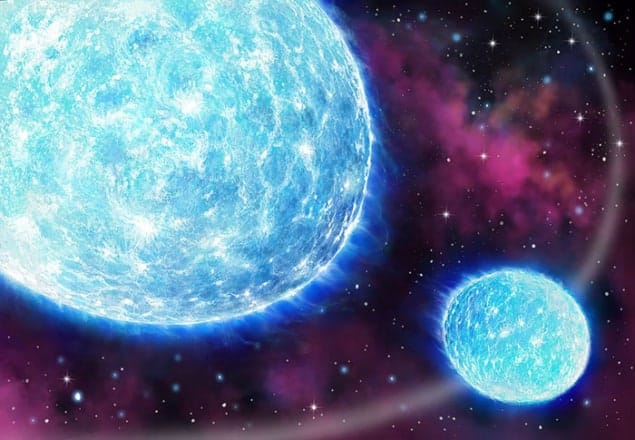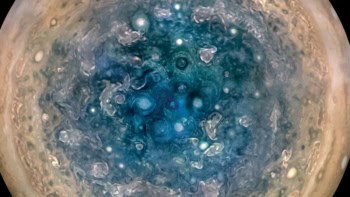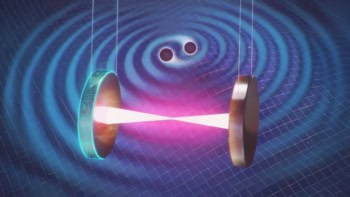Flash Physics is our daily pick of the latest need-to-know developments from the global physics community selected by Physics World‘s team of editors and reporters

Nanosatellites measure massive stellar heartbeat
The world’s smallest astronomical satellites have identified the largest “stellar heartbeat” to date. Using the nanosatellite network Bright Target Explorer (BRITE)-Constellation mission, a group of astronomers has observed the pulse and tidal events of the Iota Orionis binary star system for the first time. The BRITE-Constellation project comprises five tiny satellites – cubes measuring 20 cm across – in low-Earth orbits. As the first-ever nanosatellite mission, they are used to investigate the structure and evolution of the brightest stars using high-precision photometry. One such system is Iota Orionis, which is the brightest star in the constellation Orion’s Sword and easily visible with the naked eye. Iota Orionis is dominated by a massive blue-giant star that is in a 29–day orbit with a main-sequence class B star. While light from the system is relatively stable 90% of the time, the team, led by Herbert Pablo of the University of Montreal observed a repetitive rapid dip and sharp spike. “The variations look strikingly similar to an electrocardiogram showing the sinus rhythms of the heart, and are known as heartbeat systems,” says Pablo, who is also a member of the Centre for Research in Astrophysics of Quebec (CRAQ). The phenomenon is caused by the stars coming closer together for a short time during their elliptical orbit. The closer contact means the gravitational forces between the stars become so strong that their shapes distort, their light is seen to pulse and quakes are triggered in the star. This the first time that a heartbeat and induced quakes have been observed in such a massive system (35 times the mass of the Sun). The findings, presented in the Monthly Notices of the Royal Astronomical Society, could provide new clues as to how massive stars evolve.
Floating spectrometer could detect oil spills

A floating sensor that can detect an oil spill in water and identify the type of oil present has been launched by Óscar Sampedro and José Salgueiro of the University of Vigo in Spain. The device uses the fact that crude or refined oil absorbs ultraviolet (UV) light and emits fluorescent light. Different types of oil emit different spectra of fluorescent light, and the type of oil can be determined by comparing the detected spectrum to a database of known oil types. While fluorescence is usually measured using delicate and expensive equipment, Sampedro and Salgueiro have built a low-cost and robust spectrometer based on four photodiode detectors. Each detector is covered by a cellophane film that filters out a different colour of light and the fluorescence is stimulated using UV light from inexpensive LEDs. “The four signals proved to be enough to build a specific fingerprint for every oil type used in our study, letting us identify the different types of oil,” explains Salgueiro. “This approach dramatically reduces the cost of the instrument and simplifies contamination testing.” The sensor also includes a low-cost microcontroller and a radio module that allows the device to send data and receive commands. The prototype sensor is about 30 cm in size and could be placed in a buoy. It is described in Applied Optics.
Gluons contribute 50% to proton spin
Half of the spin of the proton is associated with gluons, according to a state-of-the art calculation done by Yi-Bong Yang and Terrence Draper of the University of Kentucky and colleagues in the XQCD collaboration. Quantum chromodynamics (QCD) describes the proton as comprising three quarks that are bound together by gluons – bosons that mediate the strong force. Both quarks and gluons have intrinsic angular momentum – or spin – and physicists are keen to understand how these spins combine to give the proton its well-known spin of 1/2. Accelerator-based experiments done over the past three decades suggest that the quarks contribute about 30% of the spin, with the rest unaccounted for. As well as coming from the gluons, some of the remaining spin could be orbital angular momentum. There are also other effects that could screen the quark contribution or make some of it invisible to experiments. Calculating proton spin is extremely difficult because of the enormous strength of the strong nuclear force and the fact that calculations must consider large numbers of virtual quark–antiquark pairs that pop into and out of existence. The XQCD team is the first to use the computational technique lattice chromodynamics (QCD) to calculate the contributions of the gluons to the proton’s spin, which the researchers found to be about 50%. The calculations also suggest that screening of the quark spin is not significant, which means that the remaining 20% of the proton’s spin is probably related to orbital angular momentum and a topological effect that makes some of the quark spin invisible. The calculations are described in Physical Review Letters.
- You can find all our daily Flash Physics posts in the website’s news section, as well as on Twitter and Facebook using #FlashPhysics. Tune in to physicsworld.com later today to read today’s extensive news story on a plan to put ultracold atoms into space.



